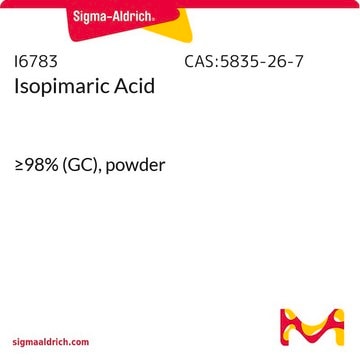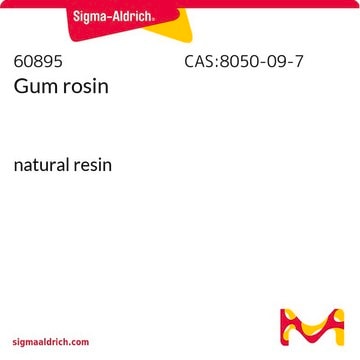SMB00089
Dehydroabietic acid
≥90% (LC/MS-ELSD)
Sinónimos:
Abieta-8,11,13-trien-18-oic acid, Dehydroabietate
About This Item
Productos recomendados
Análisis
≥90% (LC/MS-ELSD)
formulario
solid
aplicaciones
metabolomics
vitamins, nutraceuticals, and natural products
temp. de almacenamiento
−20°C
cadena SMILES
CC(C)c1ccc2c(CC[C@H]3[C@@](C)(CCC[C@]23C)C(O)=O)c1
InChI
1S/C20H28O2/c1-13(2)14-6-8-16-15(12-14)7-9-17-19(16,3)10-5-11-20(17,4)18(21)22/h6,8,12-13,17H,5,7,9-11H2,1-4H3,(H,21,22)/t17-,19-,20-/m1/s1
Clave InChI
NFWKVWVWBFBAOV-MISYRCLQSA-N
Categorías relacionadas
Descripción general
Aplicación
- to study the aging process of Pinus resins using Fourier-transform infrared spectroscopy (FTIR)
- to study the composition changes in Pinus genus with aging using Raman spectroscopy complemented with infrared spectroscopy
- to estimate resistance against biotic stress as proxy in chemical defenses in Pinus halepensis
Acciones bioquímicas o fisiológicas
Palabra de señalización
Danger
Frases de peligro
Consejos de prudencia
Clasificaciones de peligro
Acute Tox. 3 Oral - Aquatic Acute 1 - Aquatic Chronic 1
Código de clase de almacenamiento
6.1C - Combustible acute toxic Cat.3 / toxic compounds or compounds which causing chronic effects
Clase de riesgo para el agua (WGK)
WGK 1
Punto de inflamabilidad (°F)
Not applicable
Punto de inflamabilidad (°C)
Not applicable
Certificados de análisis (COA)
Busque Certificados de análisis (COA) introduciendo el número de lote del producto. Los números de lote se encuentran en la etiqueta del producto después de las palabras «Lot» o «Batch»
¿Ya tiene este producto?
Encuentre la documentación para los productos que ha comprado recientemente en la Biblioteca de documentos.
Los clientes también vieron
Nuestro equipo de científicos tiene experiencia en todas las áreas de investigación: Ciencias de la vida, Ciencia de los materiales, Síntesis química, Cromatografía, Analítica y muchas otras.
Póngase en contacto con el Servicio técnico












